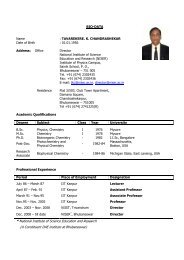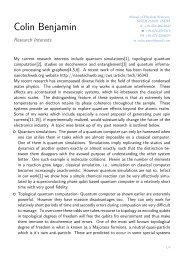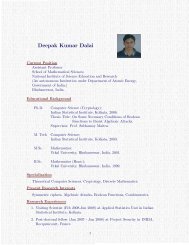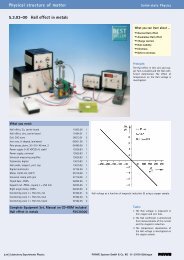Lecture-Notes (Thermodynamics) - niser
Lecture-Notes (Thermodynamics) - niser
Lecture-Notes (Thermodynamics) - niser
Create successful ePaper yourself
Turn your PDF publications into a flip-book with our unique Google optimized e-Paper software.
4.5. ENTROPY 33<br />
The entropy is defined up to an additive constant. The difference between entropies of<br />
any two states A and B is<br />
B<br />
δQ<br />
S(B) − S(A) ≡<br />
T ,<br />
where the integral extends along any reversible path connecting A and B, and the result<br />
of the integration is independent of the path.<br />
What happens when the integration is along an irreversible<br />
path? Since I − R is a cycle (see Fig. 4.8), it<br />
follows from Clausius’ theorem that<br />
⇒<br />
<br />
I<br />
<br />
δQ<br />
T ≤<br />
Therefore, in general<br />
B<br />
A<br />
I−R<br />
<br />
δQ<br />
T<br />
R<br />
δQ<br />
T<br />
δQ<br />
T<br />
≤ 0 ⇒<br />
= S(B) − S(A) .<br />
≤ S(B) − S(A) ,<br />
and the equality holds for a reversible process.<br />
A<br />
Figure 4.8: I − R (irreversiblereversible)<br />
cycle.<br />
In particular, for an isolated system, which does not exchange heat with a reservoir,<br />
δQ = 0 and therefore<br />
∆S ≥ 0 .<br />
This means that the entropy of an isolated system never decreases and remains constant<br />
during a reversible transformation.<br />
Note:<br />
i) The joint system of a system and its environment is called ”universe”. Defined in this<br />
way, the ”universe” is an isolated system and, therefore, its entropy never decreases.<br />
However, the entropy of a non-isolated system may decrease at the expense of the<br />
system’s environment.<br />
ii) Since the entropy is a state function, S(B) − S(A) is independent of the path, regardless<br />
whether it is reversible or irreversible. For an irreversible path, the entropy<br />
of the environment changes, whereas for a reversible one it does not.<br />
iii) Remember that the entropy difference<br />
B<br />
S(B) − S(A) =<br />
only when the path is reversible; otherwise the difference is larger that the integral.<br />
A<br />
δQ<br />
T







